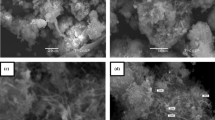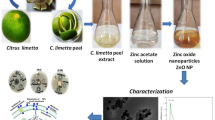Abstract
Nanomaterials are novel applicable tools to improve fruit quality by using antimicrobial agents to prolong food storage as well as contamination reduction. The objective of this study was to evaluate the cytotoxicity and antibacterial effect of zeolite/zinc oxide nanocomposite (Zeo/ZnONC) alone and with aloe vera gel (Zeo/ZnONC-AG) on Shigella sonnei and Shigella flexneri and its effect on the durability of strawberries. First, ZnO materials were characterized with X-ray fluorescence (XRF), and Zeo/ZnONC was evaluated with field emission scanning electron microscopy (FE-SEM) analyses to confirm ZnO nanoparticle formation. Subsequently, the minimum inhibitory concentrations (MIC) and minimum bactericidal concentration (MBC) of Zeo/ZnONC and Zeo/ZnONC-AG against S. sonnei and S. flexneri were assessed. The preservative application of hydrogel nanocomposite on the quality of strawberries was evaluated through the appearance of the fruits and the growth of mildew colonies. The MIC and MBC values of Zeo/ZnONC-AG against S. sonnei and S. flexneri were lower than the Zeo/ZnONC in equal concentrations of ZnO (1 mg/ml up to 8 mg/ml). The growth of mold on the surface of strawberries treated with Zeo/ZnONC-AG has shown a delay with the increase of ZnO concentration at refrigerator temperature. In conclusion, this study exhibited that Zeo/ZnONC-AG preservative has noticeable benefits in control of contamination and durability enhancement of the fruits like strawberries. The potential application of nanomaterials in industrial food suggests more evaluation on this compound by further studies.



Similar content being viewed by others
References
Sapers, G. M. (2001). Efficacy of washing and sanitizing methods for disinfection of fresh fruit and vegetable products. Food Technology and Biotechnology, 39, 305–311.
Yeganegi, M., Yazdi, F. T., Mortazavi, S. A., Asili, J., Behbahani, B. A., & Beigbabaei, A. (2018). Equisetum telmateia extracts: Chemical compositions, antioxidant activity and antimicrobial effect on the growth of some pathogenic strain causing poisoning and infection. Microbial Pathogenesis, 116, 62–67.
Parish, M., Beuchat, L., Suslow, T., Harris, L., Garrett, E., Farber, J., & Busta, F. (2003). Methods to reduce/eliminate pathogens from fresh and fresh-cut produce. Comprehensive Reviews in Food Science and Food Safety, 2, 161–173.
Heydari, S., Jooyandeh, H., Alizadeh Behbahani, B., & Noshad, M. (2020). The impact of Qodume Shirazi seed mucilage-based edible coating containing lavender essential oil on the quality enhancement and shelf life improvement of fresh ostrich meat: An experimental and modeling study. Food Science & Nutrition, 8, 6497–6512.
Alizadeh Behbahani, B., Falah, F., Vasiee, A., & Tabatabaee Yazdi, F. (2021). Control of microbial growth and lipid oxidation in beef using a Lepidium perfoliatum seed mucilage edible coating incorporated with chicory essential oil. Food Science & Nutrition, 9, 2458–2467.
Tanavar, H., Barzegar, H., Alizadeh Behbahani, B., & Mehrnia, M. A. (2021). Investigation of the chemical properties of Mentha pulegium essential oil and its application in Ocimum basilicum seed mucilage edible coating for extending the quality and shelf life of veal stored in refrigerator (4 degrees C). Food Science & Nutrition, 9, 5600–5615.
Vieira, J. M., Flores-López, M. L., de Rodríguez, D. J., Sousa, M. C., Vicente, A. A., & Martins, J. T. (2016). Effect of chitosan–Aloe vera coating on postharvest quality of blueberry (Vaccinium corymbosum) fruit. Postharvest Biology and Technology, 116, 88–97.
DuPont, H. L., Levine, M. M., Hornick, R. B., & Formal, S. B. (1989). Inoculum size in shigellosis and implications for expected mode of transmission. The Journal of Infectious Diseases, 159, 1126–1128.
Ahmed, A. M., & Shimamoto, T. (2015). Molecular characterization of multidrug-resistant Shigella spp. of food origin. International Journal of Food Microbiology, 194, 78–82.
Woolston, J., & Sulakvelidze, A. (2015). Bacteriophages and food safety (pp. 1–13).
Harris, L., Farber, J., Beuchat, L., Parish, M., Suslow, T., Garrett, E., & Busta, F. (2003). Outbreaks associated with fresh produce: Incidence, growth, and survival of pathogens in fresh and fresh-cut produce. Comprehensive Reviews in Food Science and Food Safety, 2, 78–141.
Partoazar, A., Bideskan, F. R., Partoazar, M., Talaei, N., & Dallal, M. M. S. (2020). Inhibition of biofilm formation of Staphylococcus aureus strains through ZnO/zeolite nanocomposite and its cytotoxicity evaluation. BioNanoScience, 10, 714–720.
Guo, X., Chen, B., Wu, X., Li, J., & Sun, Q. (2020). Utilization of cinnamaldehyde and zinc oxide nanoparticles in a carboxymethylcellulose-based composite coating to improve the postharvest quality of cherry tomatoes. International Journal of Biological Macromolecules, 160, 175–182.
Noshirvani, N., Ghanbarzadeh, B., Mokarram, R. R., & Hashemi, M. (2017). Novel active packaging based on carboxymethyl cellulose-chitosan-ZnO NPs nanocomposite for increasing the shelf life of bread. Food Packaging and Shelf Life, 11, 106–114.
Cisneros, L., Gao, F., & Corma, A. (2019). Silver nanocluster in zeolites. Adsorption of ethylene traces for fruit preservation. Microporous and Mesoporous Materials, 283, 25–30.
Malic, S., Rai, S., Redfern, J., Pritchett, J., Liauw, C. M., Verran, J., & Tosheva, L. (2019). Zeolite-embedded silver extends antimicrobial activity of dental acrylics. Colloids and Surfaces B: Biointerfaces, 173, 52–57.
Afrasiabi, S., Bahador, A., & Partoazar, A. (2021). Combinatorial therapy of chitosan hydrogel-based zinc oxide nanocomposite attenuates the virulence of Streptococcus mutans. BMC Microbiology, 21, 1–8.
Liu, Y.-J., He, L.-L., Mustapha, A., Li, H., Hu, Z., & Lin, M.-S. (2009). Antibacterial activities of zinc oxide nanoparticles against Escherichia coli O157: H7. Journal of Applied Microbiology, 107, 1193–1201.
Vega-Gálvez, A., Miranda, M., Aranda, M., Henriquez, K., Vergara, J., Tabilo-Munizaga, G., & Pérez-Won, M. (2011). Effect of high hydrostatic pressure on functional properties and quality characteristics of aloe vera gel (Aloe barbadensis Miller). Food Chemistry, 129, 1060–1065.
Hamman, J. H. (2008). Composition and applications of aloe vera leaf gel. Molecules, 13, 1599–1616.
Partoazar, A., Talaei, N., Bahador, A., Pourhajibagher, M., Dehpour, S., Sadati, M., & Bakhtiarian, A. (2019). Antibiofilm activity of natural zeolite supported nanoZnO: Inhibition of Esp gene expression of Enterococcus faecalis. Nanomedicine, 14, 675–687.
Partoazar, A., Bideskan, F. R., Takzaree, N., & Dallal, M. (2021). Antibiofilm activity of ZnO/zeolite nanocomposite (ZnO/ZeoNC) against Klebsiella pneumoniae and its biocompatibility in an animal model. Anti-Infective Agents, 19, 174–181.
Arsene, M. M., Viktorovna, P. I., Sergei, G. V., Hajjar, F., Vyacheslavovna, Y. N., Vladimirovna, Z. A., Aleksandrovna, V. E., Nikolayevich, S. A., & Sachivkina, N. (2022). Phytochemical analysis, antibacterial and antibiofilm activities of aloe vera aqueous extract against selected resistant Gram-negative bacteria involved in urinary tract infections. Fermentation, 8, 626.
CLSI-Clinical, and Institute, L. S. (2014). Performance standards for antimicrobial susceptibility testing, Twenty-Fourth Informational Supplement. CLSI document M100-S24, CLSI Wayne.
Soltan Dallal, M. M., Karimaei, S., Hajighasem, M., Hashemi, S. J., Rahimi Foroushani, A., Ghazi-Khansari, M., & Partoazar, A. (2023). Evaluation of zinc oxide nanocomposite with aloe vera gel for packaging of chicken fillet against Salmonella typhi and Salmonella para typhi A. Food Science & Nutrition. First published: 23 June 2023. https://doi.org/10.1002/fsn3.3528
Olawuyi, I. F., Kim, S. R., & Lee, W. Y. (2021). Application of plant mucilage polysaccharides and their techno-functional properties’ modification for fresh produce preservation. Carbohydrate Polymers, 272, 118371.
Ruffo Roberto, S., Youssef, K., Hashim, A. F., & Ippolito, A. (2019). Nanomaterials as alternative control means against postharvest diseases in fruit crops. Nanomaterials, 9, 1752.
Gunalan, S., Sivaraj, R., & Rajendran, V. (2012). Green synthesized ZnO nanoparticles against bacterial and fungal pathogens. Progress in Natural Science: Materials International, 22, 693–700.
Tiwari, V., Mishra, N., Gadani, K., Solanki, P. S., Shah, N., & Tiwari, M. (2018). Mechanism of anti-bacterial activity of zinc oxide nanoparticle against carbapenem-resistant Acinetobacter baumannii. Frontiers in Microbiology, 9, 1218.
Emamifar, A., Kadivar, M., Shahedi, M., & Soleimanian-Zad, S. (2011). Effect of nanocomposite packaging containing Ag and ZnO on inactivation of Lactobacillus plantarum in orange juice. Food Control, 22, 408–413.
Kim, I., Viswanathan, K., Kasi, G., Thanakkasaranee, S., Sadeghi, K., & Seo, J. (2022). ZnO nanostructures in active antibacterial food packaging: Preparation methods, antimicrobial mechanisms, safety issues, future prospects, and challenges. Food Reviews International, 38, 537–565.
Ali, K., Dwivedi, S., Azam, A., Saquib, Q., Al-Said, M. S., Alkhedhairy, A. A., & Musarrat, J. (2016). Aloe vera extract functionalized zinc oxide nanoparticles as nanoantibiotics against multi-drug resistant clinical bacterial isolates. Journal of Colloid and Interface Science, 472, 145–156.
Khatana, C., Kumar, A., Alruways, M. W., Khan, N., Thakur, N., Kumar, D., & Kumari, A. (2021). Antibacterial potential of zinc oxide nanoparticles synthesized using Aloe vera (L.) Burm. f.: A Green approach to combat drug resistance. Journal of Pure and Applied Microbiology, 15, 1907–1914.
Hernández-Carrillo, J. G., Orta-Zavalza, E., González-Rodríguez, S., Montoya-Torres, C., Sepúlveda-Ahumada, D., & Ortiz-Rivera, Y. (2021). Evaluation of the effectivity of reuterin in pectin edible coatings to extend the shelf-life of strawberries during cold storage. Food Packaging and Shelf Life, 30, 100760.
Ying, T., Wu, P., Gao, L., Wang, C., Zhang, T., Liu, S., & Huang, R. (2022). Isolation and characterization of a new strain of Bacillus amyloliquefaciens and its effect on strawberry preservation. LWT, 165, 113712.
Funding
This study was a part of a research project approved by the Food Microbiology Research Center, Tehran University of Medical Sciences, Tehran, Iran (contract no. 46108).
Author information
Authors and Affiliations
Contributions
A.P.: methodology and writing and editing the manuscript. S. A.: writing and editing the manuscript. M. F. G.: experimental assessment. G-K.: data curation and advisor. MM. S.D.: supervisor.
Corresponding author
Ethics declarations
Informed Consent
None.
Research Involving Humans and Animals Statement
None.
Competing Interests
The authors declare no competing interests.
Additional information
Publisher’s Note
Springer Nature remains neutral with regard to jurisdictional claims in published maps and institutional affiliations.
Rights and permissions
Springer Nature or its licensor (e.g. a society or other partner) holds exclusive rights to this article under a publishing agreement with the author(s) or other rightsholder(s); author self-archiving of the accepted manuscript version of this article is solely governed by the terms of such publishing agreement and applicable law.
About this article
Cite this article
Partoazar, A., Afrasiabi, S., Ghasemzadeh, F. et al. Antimicrobial Activity of Zeolite/Zinc Oxide Nanocomposite Containing Aloe Vera Gel Against Shigella spp. and Its Durability Effects on Strawberries. BioNanoSci. 13, 2096–2102 (2023). https://doi.org/10.1007/s12668-023-01165-3
Accepted:
Published:
Issue Date:
DOI: https://doi.org/10.1007/s12668-023-01165-3




